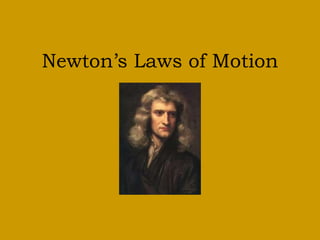Newtons laws powerpoint new.ppt
- 1. Newton’s Laws of Motion
- 2. Background Sir Isaac Newton (1642-1727) an English scientist and mathematician famous for his discovery of the law of gravity also discovered the three laws of motion. Today these laws are known as Newton’s Laws of Motion and describe the motion of all objects on the scale we experience in our everyday lives.
- 3. Newton’s Laws of Motion 1. A body tends to be in it’s state of rest or uniform motion,unless an unbalanced external force act upon it 2. Force equals mass times acceleration (F = ma)/the rate of change of momentum is directly proportional to the applied force 3. For every action there is an equal and opposite reaction.
- 4. Newton’s First Law A body tends to be in it’s state of rest or uniform motion,unless an unbalanced external force act upon it
- 5. What does this mean? Basically If the object was sitting still, it will remain stationary. If it was moving at a constant velocity, it will keep moving. It takes force to change the motion of an object.
- 6. What is meant by unbalanced force? If the forces on an object are equal and opposite, they are said to be balanced, and the object experiences no change in motion. If they are not equal and opposite, then the forces are unbalanced and the motion of the object changes.
- 7. Some Examples from Real Life Two teams are playing tug of war. They are both exerting equal force on the rope in opposite directions. This balanced force results in no change of motion. A soccer ball is sitting at rest. It takes an unbalanced force of a kick to change its motion.
- 8. Newton’s First Law is also called the Law of Inertia Inertia: the tendency of an object to resist changes in its state of motion The First Law states that all objects have inertia. The more mass an object has, the more inertia it has (and the harder it is to change its motion).
- 9. If objects in motion tend to stay in motion, why don’t moving objects keep moving forever? Things don’t keep moving forever because there’s almost always an unbalanced force acting upon it. A book sliding across a table slows down and stops because of the force of friction. If you throw a ball upwards it will eventually slow down and fall because of the force of gravity.
- 10. In outer space, away from gravity and any sources of friction, a rocket ship launched with a certain speed and direction would keep going in that same direction and at that same speed forever.
- 11. Newton’s Second Law Force equals mass times acceleration. F = ma Acceleration: a measurement of how quickly an object is changing speed.
- 12. What does F = ma mean? Force is directly proportional to mass and acceleration. Imagine a ball of a certain mass moving at a certain acceleration. This ball has a certain force. Now imagine we make the ball twice as big (double the mass) but keep the acceleration constant. F = ma says that this new ball has twice the force of the old ball. Now imagine the original ball moving at twice the original acceleration. F = ma says that the ball will again have twice the force of the ball at the original acceleration.
- 13. More about F = ma If you double the mass, you double the force. If you double the acceleration, you double the force. What if you double the mass and the acceleration? (2m)(2a) = 4F Doubling the mass and the acceleration quadruples the force. So . . . what if you decrease the mass by half? How much force would the object have now?
- 14. What does F = ma say? F = ma basically means that the force of an object comes from its mass and its acceleration. Something very small (low mass) that’s changing speed very quickly (high acceleration), like a bullet, can still have a great force. Something very small changing speed very slowly will have a very weak force. Something very massive (high mass) that’s changing speed very slowly (low acceleration), like a glacier, can still have great force.
- 15. Newton’s Third Law For every action there is an equal and opposite reaction.
- 16. What does this mean? For every force acting on an object, there is an equal force acting in the opposite direction. Right now, gravity is pulling you down in your seat, but Newton’s Third Law says your seat is pushing up against you with equal force. This is why you are not moving. There is a balanced force acting on you– gravity pulling down, your seat pushing up.
- 17. Think about it . . . • Reaction from wall • On boat • A hit • Quick sand
- 18. Review Newton’s First Law: A body tends to be in it’s state of rest or uniform motion , unless an unbalanced external force act upon it Newton’s Second Law: Force equals mass times acceleration (F = ma). Newton’s Third Law: For every action there is an equal and opposite reaction.
- 19. Vocabulary Inertia: the tendency of an object to resist changes in its state of motion Acceleration: •a change in velocity •a measurement of how quickly an object is changing speed, direction or both Velocity: The rate of change of a position along a straight line with respect to time Force: strength
